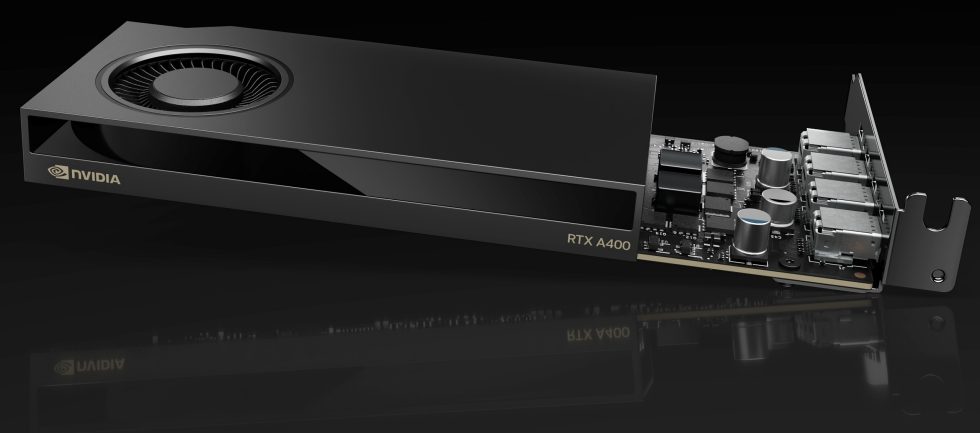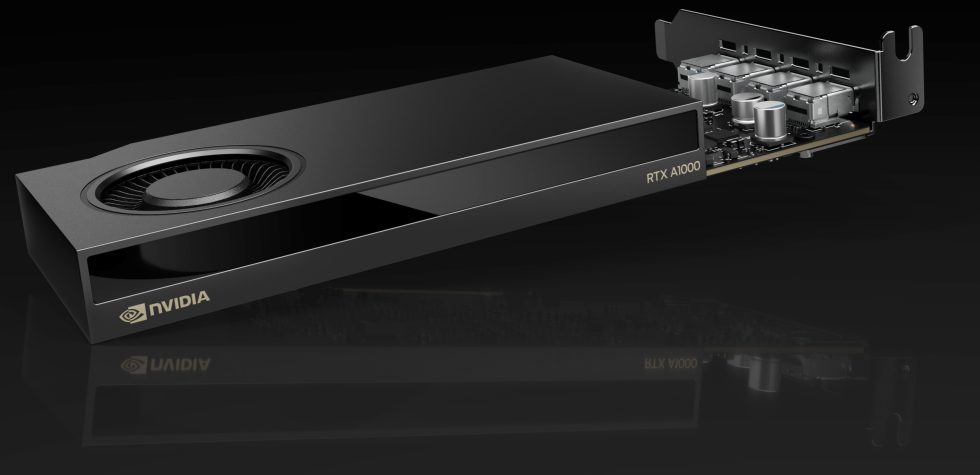The two new GPUs, based on the NVIDIA Ampere architecture, offer real-time ray tracing and support for generative AI tools on any workstation. The integration of AI into design and productivity applications is not only en vogue right now, but is continuously becoming the new standard and increasing the demand for more and more specialized computing power. This means that professionals and creatives, regardless of the size, complexity or scope of their projects, need to access more computing power.
To meet this growing need, NVIDIA is expanding its professional RTX graphics offering and rounding it out at the bottom with two new NVIDIA Ampere architecture-based GPUs for desktops: the NVIDIA RTX A400 and the NVIDIA RTX A1000. They expand access to AI and ray tracing technologies to equip professionals with the tools they need for their daily workflows. The new GPUs provide users with cutting-edge AI, graphics and compute capabilities to increase productivity and unlock creative possibilities.
Industrial designers can leverage these new powerful and energy-efficient computing solutions for edge deployments, according to NVIDIA. Creatives can increase editing and rendering speeds to produce richer visual content. Architects and engineers can seamlessly translate their ideas from 3D CAD concepts into tangible designs. Teams working in smart spaces can use the GPUs for real-time data processing, AI-powered security and digital signage management in space-constrained environments. And healthcare professionals can perform faster and more accurate medical imaging analysis. Financial professionals have always utilized expansive, high-resolution visual workspaces for more effective trading, analysis and data management. With the RTX A400 GPU, which natively supports up to four 4K displays, financial services organizations can now achieve high display density with fewer GPUs, streamlining their setups and reducing costs.
- Second-generation RT cores: real-time ray tracing, photorealistic, physics-based rendering and visualization for all professional workflows, including architecture, 3D design and content creation, where accurate lighting and shadow simulations, lighting and shadow simulations can significantly improve the quality of work.
- Third-generation Tensor Cores: Accelerates AI-powered tools and applications such as generative AI, image rendering denoising and deep learning super sampling to improve the speed and quality of image generation.
- CUDA cores based on the Ampere architecture: Up to 2x higher single-precision floating point throughput of the previous generation for significant acceleration in graphics and computing tasks.
- 4GB or 8GB of GPU memory: 4GB of GPU memory on the A400 GPU and 8GB on theA1000 GPU meet a range of professional needs, from basic graphic design and photo editing to demanding 3D modeling with textures or high-resolution editing and data analysis. The GPUs also offer higher memory bandwidth compared to the previous generation for faster data processing and processing of larger data sets and scenes.
- Encoding and decoding engines: With seventh and fifth generation encoding (NVENC) and decoding (NVDEC) engines, the GPUs provide efficient video processing to support high-resolution video editing, streaming and playback with minimal latency. Integrated AV1 decoding enables higher efficiency and smoother playback of more video formats.
NVIDIA RTX A400
The RTX A400 GPU introduces accelerated ray tracing and AI to the RTX 400 GPUs. With 24 tensor cores for AI processing, it outperforms traditional CPU-based solutions and enables professionals to run cutting-edge AI applications such as intelligent chatbots and copilots directly on their desktops. The GPU provides real-time ray tracing, allowing creatives to produce vivid, physically accurate 3D renderings that push the boundaries of creativity and realism. The A400 also features four display outputs – a first in this series. This makes it ideal for high-density display environments that are critical to industries such as financial services, command & control, retail and transportation.
NVIDIA RTX A1000
The NVIDIA RTX A1000 GPU extends the RTX 1000 series with additional Tensor Cores and RT Cores. With 72 Tensor Cores, the A1000 offers a huge upgrade over the previous generation, providing over 3x faster generative AI processing for tools like Stable Diffusion. In addition, its 18 RT Cores accelerate graphics and rendering tasks threefold, speeding up professional workflows such as 2D and 3D CAD (computer-aided design), product and architectural design and 4K video editing.
The A1000 also excels in video processing, as it can process up to 38% more encoding streams and offers up to 2x faster decoding performance than the previous generation. With their slim single-slot design and power consumption of just 50W, the A400 and A1000 GPUs offer impressive features for compact, energy-efficient workstations.
Source: NVIDIA



































5 Antworten
Kommentar
Lade neue Kommentare
Mitglied
1
Veteran
Mitglied
Veteran
Alle Kommentare lesen unter igor´sLAB Community →